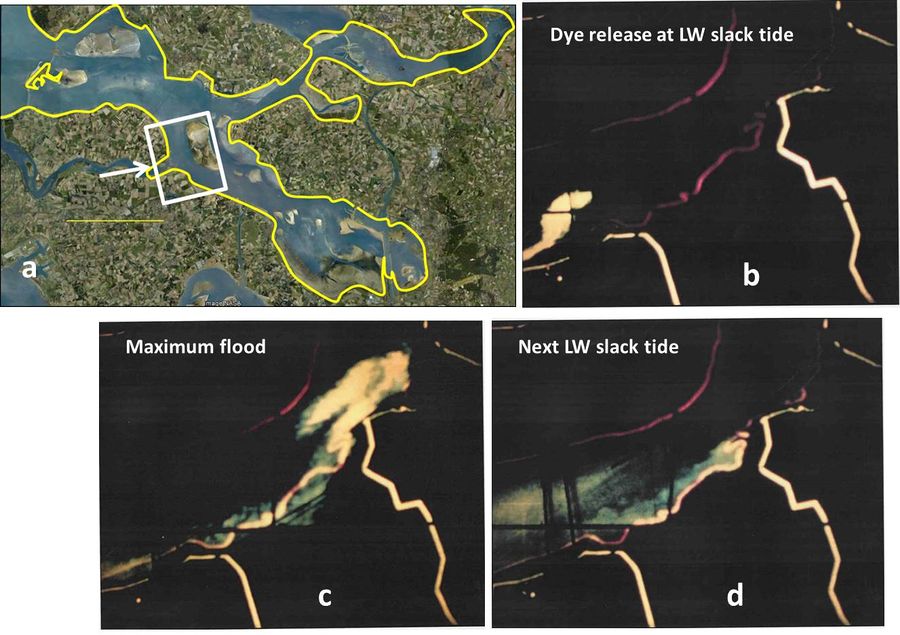Estuarine dispersion: dye experiments in the Eastern Scheldt scale model
Contents
Introduction
This article shows some results of dye experiments carried out in the hydraulic scale model of the Eastern Scheldt estuary in the Netherlands. These experiments visualise several mechanisms for longitudinal dispersion discussed in Seawater intrusion and mixing in estuaries.
The hydraulic scale model of the Eastern Scheldt estuary was built in 1970, for investigation of the hydraulic conditions in the Eastern Scheldt during and after construction of the storm surge barrier (operational in 1986) and the compartment dams (realised in 1987)[1], see Fig. 1. The scale model was mainly aimed for optimising the design and execution of the hydraulic works, but it was also used for water quality studies.
Eastern Scheldt estuary
The Eastern Scheldt estuary shown in Fig. 2 is the largest tidal basin of the Rhine-Meuse-Scheldt delta. It is a sandy multi-channel basin with muddy intertidal flats and marshes along the landward boundaries. At some places the channel depth reaches 40 m. The average depth is about 12.5 m. The tidal range at the mouth is about 3 m. The incoming tidal wave is not strongly damped when travelling through the basin; most of the tidal wave is reflected at the landward boundary. The tidal range at the landward boundary is therefore 10% larger than at the mouth. Maximum tidal currents are of order 1 m/s; the tidal excursion is typically 15 km.
The fresh water discharge to the Eastern Scheldt is very small, less than 50 m3/s on average. The estuary is well mixed over the vertical and the salinity is high, from about 25 ppt in the middle sections to about 30 ppt at the mouth.
The Eastern Scheldt hydraulic scale model
The hydraulic model is a scale model with a length of about 100 m. The horizontal scales of the Eastern Scheldt estuary are reduced by a factor 400 and the vertical scale by factor 100. The tidal time scale is reduced by a factor 40, in order to preserve the Froude number. Friction was adjusted by adding roughness elements to the model bed.
Dye experiments
Several experiments were carried out with dye releases, consisting of highly concentrated fluorescine liquid. The mean-water depth contour of the model and the 10 m depth contour were highlighted with yellow and red fluorescent paint, respectively. The hall was darkened and the model was shined with ultraviolet lamps, which made the model boundaries and the fluorescine dye patch light up. In this way the tidal dispersion of the dye could be filmed. From these films we have selected some stills, which show the dye dispersal at different tidal phases.
Experiment 1
The first experiment (Fig. 3) illustrates longitudinal dispersion by the mechanism of tidal straining: stretching of the patch of dye by lateral gradients in the flow velocity and subsequent lateral mixing. The experiment is carried out close to the junction of the northern and southern channels of the Eastern Scheldt. A small phase difference exists between the tidal currents in both channels; this phase difference also contributes to longitudinal dispersion of the dye patch.
Experiment 2
Experiment 2 (Fig. 4) illustrates the influence of shoreline irregularities and dead zones on the longitudinal dispersion of the dye patch. The dye is released near a small closed-off channel at the southern channel boundary of the Eastern Scheldt. The observed dispersion of the dye patch is also related to tidal straining.
Experiment 3
In experiment 3 the dye is released close to a large tidal flat (Krabbenkreek, at the left upper part of the pictures, Fig. 5). The exchange flow between the channel and the tidal flat is governed by tide-level variation; this exchange flow is not exactly in phase with the tidal flow in the channel (due to friction). This contributes to longitudinal dispersion.
Experiment 4
The southern entrance channel of the Eastern Scheldt is flood dominated, whereas the middle channel is ebb dominated (due in particular to the ebb-jet effect). Experiment 4 (Fig. 6) shows that a patch of dye released at LW slack tide in the southern channel is partly diverted to the middle channel after one tidal period. The experiment illustrates that residual circulation between flood- and ebb-dominated channels are an important dispersion mechanism in wide multi-channel estuaries.
Experiment 5
Experiment 5 (Fig. 7) is similar to experiment 1, but continued over a longer period. This experiment therefore shows the combined effect of different longitudinal dispersion mechanisms in the Eastern Scheldt. For this experiment, dye concentrations were measured, because concentrations became too low for visual observation. The experiment shows that longitudinal mixing is much faster than lateral mixing in wide multi-channel estuaries.
The length [math]l[/math] of the dye patch (pink) increased during the first 6 tidal cycles almost as the square root of time [math]t[/math]. This suggests that the dye dispersion can be considered as a random walk process already in this initial stage. Taking [math]l/3[/math] as a measure of the average relative displacement of water parcels during this random walk process, an estimate of the dispersion coefficient [math]K[/math] is given by [math]K \approx (\Delta l/3)^2 / 2 \Delta t[/math]. The result, [math]K \approx 200 m^2/s[/math] is similar to the dispersion coefficient determined from the observed salinity distribution in the Eastern Scheldt at small constant fresh water inflow (see Fig. 1 in Seawater intrusion and mixing in estuaries).
Related articles
Seawater intrusion and mixing in estuaries
References
- ↑ Storm Surge Barrier Eastern Scheldt (1989) Report Delft Hydraulics Z88
Please note that others may also have edited the contents of this article.
|






